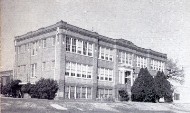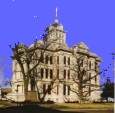Milam County Historical Commission
Milam County, Texas
Milam County, Texas






History of Milam County
(EDITOR'S NOTE: The history of Rockdale and the Rockdale Public School, has been presented in
as clear and true a manner as possible. This would have been impossible had it not been for the
information furnished me by a few of the pioneer settlers and friends who have been a
ssociated with the town since its early beginning. For co-operation in this work I am indebted
to the following: Messrs. L. H. Porter and W. Hill Marshall, and Mesdames C. K. Stribling, R. H.
Hicks, A. M. Dunnington, J. E. Longmoor, Lorena Kevil Bradley, J. L. Lanning.
In the extensive history of Milam County all credit goes to Mrs. Hubert Dennis, a very efficient
history teacher of the Rockdale School, who is also Sponsor of the Annual. The history is gotten
up entirely on research work of Mrs. Dennis in various Texas histories, assisted by information
from Mrs. Jeff T. Kemp of Cameron.—VIRGINIA HALE, Editor.)
Milam County
"To the eye Milam County presented the appearance of a vast stretch of undulating
country, threaded at intervals by clear streams of running water and divided almost
equally between timberland and prairie. All kinds of game, such as buffalo, deer,
antelope, bear, wild hogs, and turkeys were there in abundance, while the climate
was almost ideally perfect. It was the hunter's home, the pioneer's paradise, and
the poet's dream of breathing beauty."
The territory along the banks of the San Gabriel and the Brushy was occupied by
various small tribes of Indians, probably akin to the East Texas tribes. The Spanish
found them here and have given their names as the Mayeyes, the Deadoses, the Yohuanes,
Bidai, Cocos, Orcoquizas, and others. These names are found in Dr. H. E. Bolton's
articles on the subject of the San Gabriel missions. The impression one gains from
studying the meagre sources of information on these tribes is that they were not of
the semi-civilized, more stable type of Indian, but more or less of a wandering and
restless nature. They spent their days hunting in the woods along the Gabriel, fishing
in its waters or chasing buffalo on the slopes. In summer they feasted and in the
winter they shivered and starved. In summer they often followed the buffalo north
and west to the plains and here they came into conflict with their hereditary enemies,
the Apaches. Periodically they organized themselves into raiding bands and went on
the warpath with murderous intent in search of Apaches. Thus their lives were one
long idyll of savage existence, in cycles of war, the chase, orgies of feasting,
and religious festivals, until the arrival upon the distant horizon of an undreamed
of menace to their peace of mind — the Spanish conquistadores.
About 1714-1715 Spain became suddenly interested in settling Texas, for the French
were settling on the Mississippi and Red Rivers, and were getting too close to the
Spanish claims for Spain to rest comfortably. The first mention to be found of Spain
in Milam County is in the reports of Captain Ramon, who told of crossing the San Andres
(Little River) on May 31. 1716, just above its confluence with the Brazos, and of
naming another stream which emptied into it, the San Francisco Xavier. This name,
Xavier, (pronounced Hav-yer' in Spanish) was corrupted into Gabriel, and the stream
has since been known by this name. On one of Austin's early (1829) maps he names the
stream the "San Javriel." In 1720, Aguayo, a Spanish governor from San Antonio,
traversed Milam County and crossed Little River on June 12, after a delay of seventeen
days on account of high water. In 1732, Bustillo. traveling from San Antonio on a
campaign against the Apaches, reached Little River, also. In his party were one
hundred and fifty-seven Spaniards, sixty Indians, one hundred and forty pack loads
of supplies, and nine hundred horses.
In 1744, Fray Francisco de los Dolores y Viana, a missionary from the Alamo, on tour
in search of Indians, found a large village of them near the junction of the San
Gabriel and Brushy Creek. He tried to coax them to join him and enter the mission
at San Antonio, but they refused, promising, however, to visit the Alamo at a later
date. Soon four chiefs appeared in San Antonio with a request that the priests
establish a mission in this country. It was later found out that their real purpose
in asking for
a mission was to secure the aid of the Spanish and their guns against the Apaches.
Father Ortiz was dispatched to Mexico City to ask permission of the viceroy to found
the mission, and in 1746 permission was granted for the construction of three missions
on the San Xavier. In 1748, thirty soldiers were sent to protect the priests, while
in the meantime Dolores had, on his own initiative, established a mission on the
Gabriel, the first foundation before Dec. 26, 1746. The viceroy's orders were carried
out and two missions were added to this one the same year. The three were placed at
some distance from each other along the Gabriel and were named San Francisco Xavier
de Horcasitas, San Ildefonso, and Nuestra Senora de la Candelaria.* (*According to
Mr. L. H. Porter, San Xavier was on the Kolb place, Ildefonso on the fork of Brushy
and Gabriel, and Candelaria on the Porter farm.)
In 1751 there were three hundred and forty-nine Indians in the three missions. These
missions suffered heavily from the attacks of the Apaches, and in 1751 a fort was
built and more soldiers sent to guard the settlement. Smallpox reduced the population,
many Indians ran away to join a campaign against the Apaches, the priests and the
officers at the fort quarreled, and finally friction produced a tragedy in 1752 that
demoralized the whole organization of the missions. One of the priests was killed,
probably by a soldier, and after three more years of struggle against overpowering
odds, the missions were deserted (1755) and left to decay and crumble. Time has
erased them from the scene, for, like other missions of this part of Texas, they were
constructed of logs and rotted away under the work of the elements. Traces of this
settlement are still found scattered up and down the river, but nothing whole is left
as a monument to the work of the faithful and unselfish Spanish padres. Some traces
of a dam may be seen on Ditch Valley farm, faint marks of irrigation projects may be
found, some stones used in the construction of the missions may be located, and even
the bones of some of those connected with the missions have been unearthed. Many
legends are related in connection with happenings in the vicinity, but we are
interested in facts only in this account. Interest in settling Texas waned soon
after, for France ceded Western Louisiana to Spain in 1762, and no further effort
to inhabit Milam County was made by Spain.
From 1755 to 1823 seems to be a blank in the history of Milam County. It is probable
that during this time the country was visited at various times by other Spaniards or
by the American filibusters of the period, but no authentic data are to be found of
such occurrences.
In 1823 a venturesome young American, who had spent some time in Mexico after its
struggle for independence from Spain was over, and there had heard of Texas and its
opportunities, decided to visit the land; so, in his home town, Nashville, Tennessee,
he organized a company to explore the wild country. Sterling C. Robertson, the son
of a wealthy planter, was born in Nashville. October 2, 1785, and was reared there.
He was a well-educated young man and had served as a major in the War of 1812. The
company from Nashville reached the Brazos in 1823 and formed a camp at the mouth of
Little River. From this headquarters they spent several months hunting, fishing, and
exploring the adjacent territory, and, during the time, Robertson visited Austin's
colonies and others, gathering information with the idea of obtaining a grant of
land and bringing in families from Nashville and Tennessee. Upon his return home,
he arranged to purchase a contract (dated April 25, 1825) with the Mexican government
that had been made by Robert Leftwich, for the settlement of eight hundred families
on the Brazos, Little River, and the San Gabriel. The contract gave him six years to
settle the eight hundred families. Late in 1829, at his own expense, Robertson
introduced one hundred families into Texas; but they were held up at Nacogdoches by
the Mexican military authorities, who had received false reports in regard to Colonel
Robertson and his colonists. It was not until 1830 that the Nashville Company reached
the Brazos, and this only after having led the authorities to believe that they were
going to join one of Austin's colonies. It was not until April 29, 1834, that Robertson
finally cleared up the matter with the government in Mexico and the contract
reinstated. In the summer of 1834 Robertson made his headquarters on the west bluff
of the Brazos, (five miles from Marlin) near the falls, and laid out a town called
Sarahville de Viesca. There was a ford on the river at this point, which, in part,
accounts for this choice of a site. The name Viesca was in honor of the Spanish
governor of the time. Alexander Thompson, Robertson's right-hand man, established
another settlement down the river as a distributing point for settlers. This site
was on the west bluff of the Brazos just below the junction of the Little River and
the Brazos (near Hearne). The place was known as Fort Nashville. A fort of cedar logs
was constructed and business was transacted here and records preserved. Nashville
later became the most important settlement in the" colony and the capitol. Also, when
a discussion arose in the time of the Republic over the selection of a permanent
capital for Texas, Nashville came within a few votes of winning the honor. The first
land office was opened about October 1, 1834, and in 1835 Robertson made a trip back
to the States to induce settlers to follow him to Texas.
Ten miles south of Nashville, Tenochtitlan was established on the crossing of the Old
Spanish Trail, and became an important settlement, while north of Nashville, Sterling
(near Calvert) became another distribution point.*
(*Judge Calvert's granddaughter, Mrs. J. W. Doremus of Dallas, still still owns the
plantation at the original site of the village. Her title is in the form of a
Spanish land grant dated 1825)
One of the first permanent settlements in Robertson's colony was Jones Prairie,
settled in 1833 by Joseph P. Jones, who came from Illinois and obtained a league of
land in the vicinity. A later point of importance was Port Sullivan, near the mouth
of Little River. Davilla. one of the oldest settlements, had its beginning when the
Spanish government sold to Miguel Davila a grant of land on October 18, 1833.
Robertson's original grant included roughly the section embraced as follows: The west
bank of the Navasota River south to the Old San Antonio Road (or Spanish Trail),
along the road west to the divide between the Brazos and the Colorado, along the
ridge north to the Old Comanche trail, thence east to the Navasota. His grants
included parts of the present Brazos, Burleson, and Hill Counties, and all of
Williamson, Milam, McLennan, Bell. Limestone. and Navarro counties. The territory
was given the name of the Municipality of Viesca, and delegates from the district
were always designated as being from Viesca. Other counties included in this
municipality were Burnet, Lampasas, Bosque, Coryell, Hamilton, Erath, Hood, Comanche,
Brown, and Eastland.
Robertson proved himself a wise and farsighted empresario, and. before the revolution,
he had introduced more than six hundred families to his colony. He never spared
himself expense and labor for their interests, and was a gentleman of culture,
intellectual, unselfish, enterprising, patriotic, and a good leader and a statesman.
He lived on his farm in what is now Robertson County until his death on March 4,
1842, at the age of fifty-seven years.
Milam County played her part in the Texas Revolution, and in the period of the
Republic had a hand in all affairs. Again Sterling C. Robertson was leader in his
colony. He was a delegate from Viesca (official name of Robertson's colony, also
known as the Nashville colony) to the convention of March 1, 1836, which was called
by the general council to meet at Washington-on-the Brazos, and. on March 2, he
signed his name with fifty-seven others to the Declaration of Independence, which
was penned by George C. Childress. Childress had assisted Alexander Thompson in the
establishment of Old Nashville. A few days later, Robertson took part in the drawing
of a Constitution for the Republic of Texas, and again was one of the signers of the
document. When the convention received news of the fall of the Alamo, it disbanded at
once (March 17), and Robertson returned hastily to Viesca to organize a force to help
fight the Mexicans. Forming a company, he marched to the aid of Houston. He and his
men participated in the Battle of San Jacinto, and, for his heroic services, Robertson
was given six hundred and forty acres of land. During the "Runaway Scrape," Robertson's
colonists deserted their homes, and, after this, some of the villages practically
disappeared. The first man to move back to Viesca was John Marlin, and later Captain
Joseph Daniels. famous Indian fighter, built Fort Milam on the site of old Viesca.
In the latter part of the year 1836, the Indians became very troublesome, and
Robertson organized a ranger company to protect his colonists from attacks. Many
accounts of Indian raids and Indian fights are preserved from this period of Milam
County history, but it is hard to sift the truth from the legendary accounts of these
events. One story that is typical of the Indian situation is the history of the Mercer
brothers, Peter and Jesse, and a man named Orr who settled on the Gabriel, west of
Cameron, and who were attacked by the Indians. A bluff known to this day as Mercer's
Bluff is said to have been the spot where Peter Mercer, Orr, and a negro servant l
eaped to their death in an effort to escape the marauders. It is said also that the
town of Cameron is located on the spot where an Indian fight once took place.
On December 26. 1835, nineteen days after Ben Milam fell at San Antonio, the
provisional government of Texas had changed the name of the municipality of Viesca
to Milam Land District. We therefore have the honor of being the first district
named for a hero of the revolution. When the first Senate of the Republic was called
in session, Robertson was elected from the District of Milam and served two terms.
Milam was the first county organized after the revolution, and Nashville was the
county seat. Early in 1836, Massillon Farley was named County Judge, and William
Thompson, County Clerk.
In 1837, the first county court was held at old Nashville. The name of the sheriff
was John Beal. In the early fifties the district was divided into many smaller
counties.
In January, 1842, an act of the Congress of the Republic named commissioners to
select a permanent county seat of Milam County to be called "San Andres." But about
this time Captain Ewen Cameron, a Texas ranger and a member of the Mier Expedition,
met his death by special order of Santa Anna, and it was decided to name the new
town for him. In 1846, Milam County was organized as now constituted, and Cameron
became the county seat. The town was built on a tract of sixty acres donated by
Captain Daniel Monroe, and he and a group of pioneers founded the county seat. The
first courthouse was erected in 1846 and W. W. Oxsheer was District Clerk, Isaac
Standifer, Chief Justice, Francis Duffau, County Clerk, and John McLennan, Sheriff.
(This building was moved and another erected later. In 1874, the second building
burned, and the records were destroyed; in 1875 a new building was constructed,
only to be condemned in 1889. The fourth and present courthouse was built in 1892
at a cost of $75.000.)
In 1846, Texas was annexed to the United States. For the next fifteen years Milam
County heroes were mostly those who gave their attention to handling the Indian
problem, and particularly do we remember with pride and praise the Texas Rangers
of the period who gave their courage and skill to help shape the destiny of Texas.
Among the famous Texas rangers and Indian fighters of Milam County who gave us one
of our most illustrious heroes of the Civil War period in his son. was Shapley P.
Ross, father of Lawrence Sullivan Ross. Ross was one of the earliest settlers in
Milam County. and his cabin home was on the site of Cameron. The son was born in
Iowa (1838) but came to Texas with his family at the early age of one year. In the
notes of W. W. Oxsheer on life in Milam County in early days is the following
interesting mention of Ross: "I remember seeing one there (Old Nashville) at a horse
race which I attended on the Fourth of July, 1840. He was then a boy and a rider in
one of the races, which I think he won. this being the subsequently famous Indian
fighter and distinguished Governor Sul Ross." Sul Ross attended school at Baylor,
Waco, where his family finally made their permanent home, and, later, at Florence
Wesleyan University in Alabama. In 1858, he organized a company of Indian warriors
and went to the support of Major Earl Van Dorn, who was leading the United States
troops against the Comanches. He took part in the battle of Wichita against the
Indians, and in this battle rescued an eight-year-old white girl who was adopted
by his mother and named Lizzie Ross. In 1859, Ross was placed at the head of a
company of sixty Texas rangers. In 1860, in a battle with the Comanches on Pease
River, Peta Nocona, the chief, was killed, and Ross discovered the chief's wife to
be a white woman. She was identified as Cynthia Ann Parker, made captive by the
Indians in childhood (1836). In 1866, Ross entered the Confederate army, and it is
here, perhaps, that he deserved the name of hero most sincerely, for he entered as
private soldier, and, on account of his deeds of daring, was soon promoted to the
rank of Brigadier-General. He served throughout the war, took part in one hundred
and thirty-five battles, and had five horses shot from under him. He was closely
associated with Generals Johnston and Hood. After his return to Texas, he continued
to interest himself in the affairs of state, serving as Senator (1881-1883), as
Governor in 1886, and. finally, as president of A. and M. College until his death
in 1898.
Milam County furnished her share of Confederate soldiers other than Ross, and in the
roster of names of those who saw service were the following: Captain P. M. Kolb,
Solon Joynes, Rev. W. E. Copeland, Captain Tracy. J. S. Perry, A. P. Perry, C. H.
Coffield, Fred A. Graves, Captain J. B. Kemp, Dr. L. J. Turner, Captain L. L. Lee,
and others whose records are not to be found at this late date.
From the time of the Civil War forward the story of Milam County has been one of
consistent progress. Today "Matchless Milam" is one of the most outstanding counties
of central Texas. Its improved highways, charming towns and villages, stately
courthouse, efficient school system, colorful historic spots, and congenial populace
all summed up together form what could be considered the "perfect" county of God's
great Universe.
.
History of Milam County, TX
by Mrs. Lucille McCann Dennis
Published in 1936 Rockdale Lair
Virginia Hale - Editor
by Mrs. Lucille McCann Dennis
Published in 1936 Rockdale Lair
Virginia Hale - Editor
.